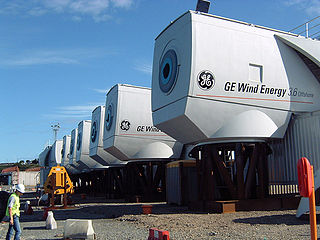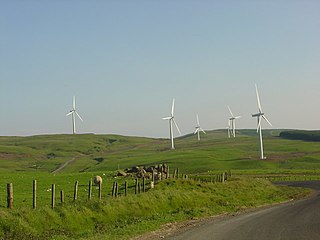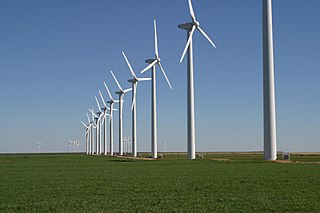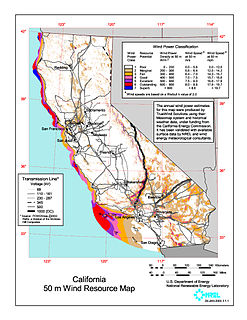
A wind farm or wind park is a group of wind turbines in the same location used to produce electricity. A large wind farm may consist of several hundred individual wind turbines and cover an extended area of hundreds of square miles, but the land between the turbines may be used for agricultural or other purposes. A wind farm can also be located offshore.

Arklow Bank Wind Park is a 25 megawatt offshore wind farm generating electrical power for the Wicklow region in Ireland. It is the first offshore wind farm in Ireland, and the world's first erection of wind turbines rated over 3 MW. It is located on the Arklow Bank, a shallow water sandbank in the Irish Sea, around 10 kilometers (6.2 mi) off the coast of Arklow with an area of 27 by 2.5 kilometres.

Wind power has become a significant energy source within South Australia over the past decade. As of 2015, there was an installed capacity of 1,475 MW, which accounts for 34% of electricity production in the state. This represents 35% of Australia's installed wind power capacity.

Wind power in Texas consists of many wind farms with a total installed nameplate capacity of 22,637 MW from over 40 different projects. Texas produces the most wind power of any U.S. state. According to ERCOT, wind power accounted for at least 15.7% of the electricity generated in Texas during 2017, as wind was 17.4% of electricity generated in ERCOT, which manages 90% of Texas's power.

Wind power in Ohio has a long history, and as of 2016, Ohio had 545 MW of utility-scale wind power installations installed, responsible for 1.1% of in-state electricity generated. Over 1000 MW more were under construction or pending approval. Some installations have become tourist attractions. There has been a sudden increase in generating capacity, as total windpower generation in the state in 2010 was just 9.7 MW.

Making up more than 35% of the state's generated electricity, Iowa is a leading U.S. state in wind power generation. The development of wind power in Iowa began with a state law, enacted in 1983, requiring investor owned utilities purchase 105 MW of power from wind generation. In 2016, over 20 billion kWh of electrical energy was generated by wind power, representing 36.6% of in state electricity production. As of February 2016, Iowa had over 6,974 megawatts (MW) of capacity. By 2020 the percentage of wind generated electricity in Iowa could reach 40 percent.

Biglow Canyon Wind Farm is an electricity generating wind farm facility in Sherman County, Oregon, United States. It is owned by Portland, Oregon based Portland General Electric and began operations in 2007. With the completion of phase 3 of the project it has a generating capacity of 450 megawatts. It is located roughly five miles (8 km) northeast of Wasco, Oregon, and about ten miles (16 km) southeast of Rufus, Oregon. Biglow Canyon Wind Farm covers 25,000 acres (10,000 ha) in the Columbia River Gorge.

The Shiloh wind power plant is a wind farm located in the Montezuma Hills of Solano County, California, USA, close to Bird's Landing and Collinsville, 40 miles (64 km) northeast of San Francisco. It has a nameplate capacity of 505 megawatts (MW) of power and was built in four stages between 2005 and 2012.

New York State ranked 11th in the United States at the end of 2013 for installed wind power capacity, with 1,722 MW installed. In 2016, wind power provided 2.94% of in state energy production.

Hadyard Hill Wind Farm is located in Carrick district of South Ayrshire. Costing £85 million, the wind farm consists of 52 three-bladed Vestas wind turbines, each capable of generating 2.3 megawatts (MW) of power, giving a total output of 120 MW. This was Britain's most powerful wind farm when it was commissioned in March 2006.

Wind power in Illinois provided 6.2% of the state's generated electrical power in 2017 and 8.3% of electrical power sales. At the end of 2017, Illinois had 4,464 megawatts (MW) of wind power installed, ranking sixth among states for installed wind turbine capacity.
GE Wind Energy is a branch of GE Renewable Energy a subsidiary of General Electric. The company manufactures and sells wind turbines to the international market. In 2016, GE was the second largest wind turbine manufacturer in the world.

As of 2016, Arizona has 268 megawatts (MW) of wind powered electricity generating capacity, producing 0.5% of in-state generated electricity.
The following outline is provided as an overview of and topical guide to wind energy:






















